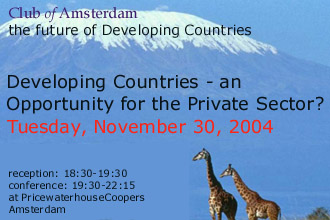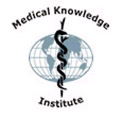
Jacques van der Gaag about the future of Developing Countries

Prof.dr. Jacques van der Gaag
Dean, Faculty of Economic Sciences and Econometrics, University of Amsterdam
| The Millennium Development Goals Who’s kidding who? The global development community, big international players like UNDP and the World bank, but also bi-lateral donor agencies, large NGO’s and others, have reached agreement about a set of development goals that should be reached by the year 2015. The first, and best known, of these goals is the reduction of world poverty by 50%. To state this more precisely, the international head count ratio, i.e. the percentage of people living on $ 1,- per day or less, is supposed to be cut in half by 2015. In 1981, the global headcount ration was 40.4%. This was reduced to 27.9% by 1990, and to 21.1% in 2001. A steady and impressive decline in poverty. If this trend continues, the best available prognoses show that then, by 2015, the poverty rate will be down to 15.0%. At first sight, this is a development success story. But a closer look may lead to another view: Virtually all the progress is due to the impressive growth performance, during the past two decades, of China. More recently, another populous country, India, has also registered impressive growth. Add these two countries together, and take into account their huge populations, and most of the downward trend is explained. For Latin America and the Middle East, current projections show hardly any poverty decline, and for Eastern Europe and Sub-Saharan Africa, the trend is upwards! Still, strictly speaking, and ignoring interregional variation, the first Millennium Development goal will be reached in 2015, if current trends continue. Unfortunately, this cannot be said of the other seven MDG’s. The situation for MDG #6 is especially dramatic. This goal calls for “combating HIV/AIDS and malaria”. While not very specific, the current situation already makes it possible that, most likely, the HIV/AIDS situation in the world will be worse in 2015, rather than better. And the same is likely to be true for malaria. For HIV/AIDS the picture is currently as follows: almost 40 million people are infected, three million people died in 2003 alone and five million additional people get infected every year. Still, according to their own website, the Global Fund hopes that within five years, 1.6 million people will be treated for AIDS. But in five years time 25 million more people will be infected! Similarly, the WHO’s so-called 3×5 initiative, which calls for three million people to be treated in 2005, is failing: the current count is 450,000 (June 2004). Clearly, the gap between what needs to be done and what is being achieved is growing rapidly. For malaria, the picture is different, but the conclusion is more or less the same: progress is hard to find and much too slow for what is needed. A new problem there is that the standard drug, chloroquine is no longer effective. The new drug of choice, artemisinin, is, unfortunately too expensive for most of the poor who suffer from malaria, if it is available at all. What is needed is a global effort to massively produce the new drug and put it on the market at highly subsidized prices. A new study estimates that, annually, the cost of such a subsidy would amount to between 300 and 500 million US $. Just a fraction of the costs of HIV/AIDS treatment, but still a substantial amount. However, the old drugs were cheap, preventive measures such as bed nets are relatively cheap, and all are very cost effective. Still, every two minutes, two children die in Africa alone, from malaria. It is hard to believe that, even if the change to the new drug can, with a global effort, be achieved, that alone will be enough to make progress in the fight against the major killer. The other MDG’s are in the area of education, maternal health, child health and some broader area’s (such as the environment). True, regional progress can be expected for some of those, but in general the expectation is that none of the goals will be reached as stated. That is a sad state of affairs. The first goal will be reached, but only if China and India continue on their aggressive economic growth paths, and all the other targets will be missed. One may wonder what the point is of setting goals for the world, and then failing to reach them. One would expect, given these bleak projections, that there would be a global outcry and a massive effort to improve the situation. But a few years after declaring these MDG’s, the world has moved on the other things, like the war on terror. The war effort in Iraq, thus far, costs US $ 300 billion, and the Paris Club just took US$ 30 billion of Iraqy debts of the books (an amount that can increase to 90 billion). Finding money for goals that the global powers do believe in, does not seem to be the problem. But if we, collectively, do believe so little in those MDG’s that we seem to be unable to generate the necessary resources to reach them, who are we kidding but ourselves? |
Prof.dr. Jacques van der Gaag
Dean, Faculty of Economic Sciences and Econometrics, University of Amsterdam is our moderator at the Club of Amsterdam evening about the future of Developing Countries, Tuesday, November 30, 2004
News about the Future

Stem Cells and Regenerative Medicine
by National Academy of Sciences
Scientists hope that by growing stem cells in laboratories they can generate specific tissues, such as heart, lung, or kidney tissue, which could then help repair damaged and diseased organs or provide alternatives to organ transplants. Many of the illnesses cited as potential targets of stem cell therapy – such as diabetes, heart disease, spinal cord injury, and Parkinson’s disease – have few or no treatment options, so millions of Americans are looking for cures.
The ability to take tissue derived from stem cells and transplant it into the human body to restore lost function may be a long way off, but some studies involving animals have been encouraging. For example, transplanted embryonic stem cells from mice have restored some insulin regulation ability in mice with diabetes, relieved symptoms of Parkinson’s disease in rodents, and partially restored neural function in animals with spinal cord injuries.

Landmark report could influence the future of medicines in Europe and the world
Priority Medicines for Europe and the World, commissioned by the Dutch Government as current president of the European Union (EU), identifies a priority list of medicines for Europe and the rest of the world, taking into account Europe’s ageing population, the increasing burden of non-communicable illnesses in developing countries and diseases which persist in spite of the availability of effective treatments. The report looks at the gaps in research and innovation for these medicines and provides specific policy recommendations on creating incentives and closing those gaps.
“This report identifies health gaps and potential solutions. It is particularly timely for a continent where an ageing population faces increasing health problems, and for a world where old and new threats no longer respect national borders,” said Dr. Lee Jong-wook, Director-General of WHO.
about the future of Developing Countries

It Works: Rural Health-Care Tech
by Wired
With degrees in medicine and engineering, Vikram Kumar could have plenty of lucrative opportunities. Instead, he’s opted for a venture with dicey moneymaking prospects. The chief customers of Dimagi, his two-year-old startup, are nonprofit health agencies in developing countries.
With software co-developed by Dimagi, nurses in India manage information collected in the field on more than 70,000 patients. And in rural South Africa, outreach workers use software that Dimagi helped develop to distribute HIV test results in remote settings while ensuring confidentiality.

World Development Report 2004: Making Services Work For Poor People
Broad improvements in human welfare will not occur unless poor people receive wider access to affordable, better quality services in health, education, water, sanitation, and electricity. Without such improvements in services, freedom from illness and freedom from illiteracy – two of the most important ways poor people can escape poverty – will remain elusive to many.
The World Development Report 2004: Making Services Work for Poor People says that too often, key services fail poor people – in access, in quantity, in quality. This imperils a set of development targets known as the Millennium Development Goals (MDGs) which call for a halving of the global incidence of poverty, and broad improvements in human development by 2015.
Summit for the Future 2005: Healthcare
| Club of Amsterdam Summit for the Future – Visions & Strategies for 2020 Date: January 26-28, 2005 Location: HES Amsterdam School for Business, Amsterdam, The Netherlands |
| Is Globalisation the single biggest factor affecting all our visions and strategies for 2020? Is it a threat to the fabric of society – or are those who do not join the people we should be keeping an eye on? Are all innovation and production gradually shifting to the BRICK countries by 2020 (Brazil, Russia, India, China, Korea)? Will Europe simply turn into the world’s retirement home? Or will the current knowledge centres in UK and The Netherlands switch to Ireland, Sweden, Finland and Australia? How can we change Brain Drain into Brain Gain – or perhaps Brain Circulation is a better phrase? At the end of January 2005, we’re putting the pick of the strategic thinkers together for our international “Summit of the Future”. It will be a creative clash of inspiration. We will debate the significance of global trends in the open plenary sessions – followed by workshops in five key knowledge streams. |
Trade / Service Industry Energy Healthcare Media & Entertainment Science & Technology |
Summit for the Future 2005 – see: https://clubofamsterdam.com/2020/10/27/summit-for-the-future-2005/ |
Recommended Book

The World Ahead: Our Future in the Making
by Federico Mayor, Jerome Binde
Global Development Learning Network
| Global Development Learning Network The Global Development Learning Network uses distance learning technologies and methods to facilitate interactive, cost-effective learning and knowledge-sharing for sustainable development and poverty reduction. GDLN Centers around the world offer a unique set of services to development practitioners. The Global Development Learning Network (GDLN) is a worldwide partnership of distance learning centers (GDLN Centers) and other public, private, and non-governmental organizations committed to development learning and development dialogue for lasting poverty reduction. Offering a unique combination of distance learning technologies and methods, GDLN facilitates timely and cost-effective knowledge sharing, consultation, coordination, and training. Through GDLN, individuals, groups, and organizations design and deliver courses, seminars, and other activities that cover the full range of development issues. GDLN Centers around the world have facilities for videoconferencing, web-based learning, and face-to-face interaction and also offer logistical support and facilitation services. These provide cost-effective, fast, and high-impact alternatives to traditional meetings and courses, enabling people around the world to connect with each other without having to travel. Activities do not need to be delivered in a concentrated period of time because people can continue working even as they participate in events. This gives them time and flexibility to read background materials; prepare real assignments related to their actual work; and interact with local peers for an enhanced learning experience. |
 |

Club of Amsterdam Upcoming Events
| Special Events | |
| January 26-28, 2005 | Summit for the Future 2005 |
| Club of Amsterdam Season 2004/2005 | |
| October 27, 2004 | the future of ICT |
| November 30, 2004 | the future of Developing Countries |
| February 23, 2005 | the future of the Service Industry |
| March 30, 2005 | the future of Water |
| April 27, 2005 | the future of Branding |
| June 1, 2005 | the future of Robotics |
| June 29, 2005 | the future of Philosophy |
| . |
















Customer Reviews
Thanks for submitting your comment!